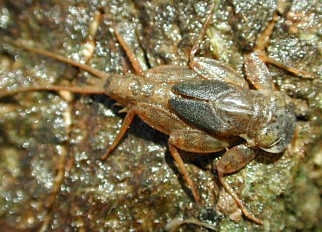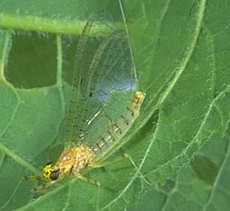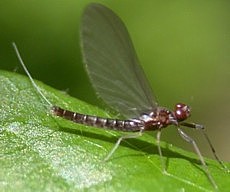|
|
ARTHROPODS:
Insects»
Spiders»
Centipedes»
Millipedes»
Sowbugs»
Harvestmen»
Mites
& Ticks»
Scorpions»
Identification
Tips»
About
the Critter Files»
Links» |
|
|
|
 |
MAYFLIES
Critter
Files/Insects/Mayflies
By Blake Newton
University of Kentucky Department of Entomology |
| |
|
| Common
Kentucky Mayflies: |
| |
| TAXONOMY |
KINGDOM: Animalia
| PHYLUM: Arthropoda | CLASS: Insecta | ORDER: Ephemeroptera (mayflies) |
| |
WHAT
IS A MAYFLY?
LIFE CYCLE
ECOLOGY
PEST STATUS
COMMON KENTUCKY MAYFLIES
COLLECTING & PHOTOGRAPHY
MAYFLY FACTS
MYTHS, LEGENDS, AND FOLKLORE |
| |
| WHAT
IS A MAYFLY? |
|
| Adult mayflies have 2
pairs of wings that are held over their bodies when they are not flying.
The front pair of wings is much longer than the back pair (which
are tiny or absent in a few species). Mayflies have 2 or 3 long
"tails" that extend from the tips of their abdomens. Mayfly
adults do not have functional mouthparts. Young mayflies, called
"naiads", are fully aquatic. They are flattened and
have 3 hair-like tails on the tips of their abdomens, along with leafy
gills all along the sides of their abdomens. Unlike adults,
mayfly naiads have chewing mouthparts. As with all insects,
mayflies have 6 legs, 3 body parts, and 2 antennae. |
|
| SIZE:
Most mayfly adults and naiads are ½" - 1" long. |
| |
| LIFE
CYCLE |
|
Mayflies
have incomplete metamorphosis. Eggs are placed underwater
by adult mayflies. After hatching, naiads may live underwater
for several years before moving to the water surface to molt into
"subimagos." The subimago is a stage in-between
the naiad and the adult mayfly: like the adult, it has wings, but
it is unable to mate. The subimago usually molts into a full-grown
adult in a few hours. Adults only live for a day or two, just
long enough to mate and lay eggs. |
| |
 Mayfly
Naiad (B. Newton 2002)
Mayfly
Naiad (B. Newton 2002) |
| |
| ECOLOGY |
|
Most mayfly naiads
are omnivores, feeding on algae, underwater plants, debris, and
tiny aquatic animals. They are most commonly found clinging
to the undersides of rocks in fast-flowing streams, but a few species
are found in ponds and lakes. Although mayflies used to be
very common, the naiads are especially sensitive to pollution, and
these days they occur only in very clean water. Mayfly adults
do not feed, but they are an important food source for birds and
fish. Mayfly mating often occurs in a giant swarm, with males
using their enlarged front legs to grab and hold females. After
mating, females are ready to lay eggs within just a few hours.
|
| |
| PEST
STATUS |
|
Mayflies
are not normally considered pests. Occasionally, many mayflies will
emerge from a body of water at the same time, which leads to piles
of foul-smelling mayflies that all die at the same time.
|
| |
| COMMON
KENTUCKY MAYFLIES |
|
|
FAMILIES:
Ephemeridae, Heptaginiidae, others
There
are several common mayfly species in Kentucky, but most are very
similar in appearance and behavior. It is difficult even for
experts to tell them apart. The mayfly pictured below right
was photographed near Laurel River Lake in Kentucky. It is
a very small species, only about 1/4" long, and is an example
of a mayfly that lacks rear wings. |
| |
 Mayfly
(R. Bessin 2001)
Mayfly
(R. Bessin 2001) |
 Mayfly
(B. Newton 2002)
Mayfly
(B. Newton 2002) |
|
| |
| COLLECTING
& PHOTOGRAPHY |
|
Despite their name,
mayflies can also be found in June, July, and August (not just May!).
Look for them near fast flowing streams and lakes. Mayflies
will often come to lights on summer nights if there is water nearby.
Because adult mayflies usually emerge from the water at very
specific times of the year, depending on the species, they are very
common at certain times, impossible to find at others. Mayfly
naiads, on the other hand, can be found at almost any time of the
year in clear streams. Pick up a rock from a stream, look
under it, and you'll probably see a mayfly naiad. Mayfly naiads,
like dragonfly and damselfly naiads, should be preserved in alcohol.
Unlike some other aquatic
insects, mayfly naiads usually do not do well in home aquariums.
Most mayflies need running water with lots of oxygen- a condition
that is difficult to maintain with an aquarium. |
| |
| MAYFLY
FACTS |
|
Mayflies have survived
mostly unchanged for 350 million years according to scientists.
So they were around before dinosaurs even existed!
Like many aquatic insects,
mayfly naiads need clean water to live. Because of this, scientists
can tell if a stream is polluted or not based on whether mayfly
naiads are present. Read more about using insects to determine
water quality: http://www.aces.edu/pubs/docs/A/ANR-1167/ANR-1167.pdf
|
| |
| MYTHS
- LEGENDS - FOLKLORE |
|
Have you heard any
myths, legends, or folklore about mayflies? If so, let us
know.
|
Original document: 25 May 2004
Last updated: 25 May 2004
Photos courtesy R. Bessin and B. Newton, University of Kentucky
The Kentucky Critter
Files are maintained by Blake Newton, Department of Entomology, University
of Kentucky.
Contact: blaken@uky.edu
|
|

